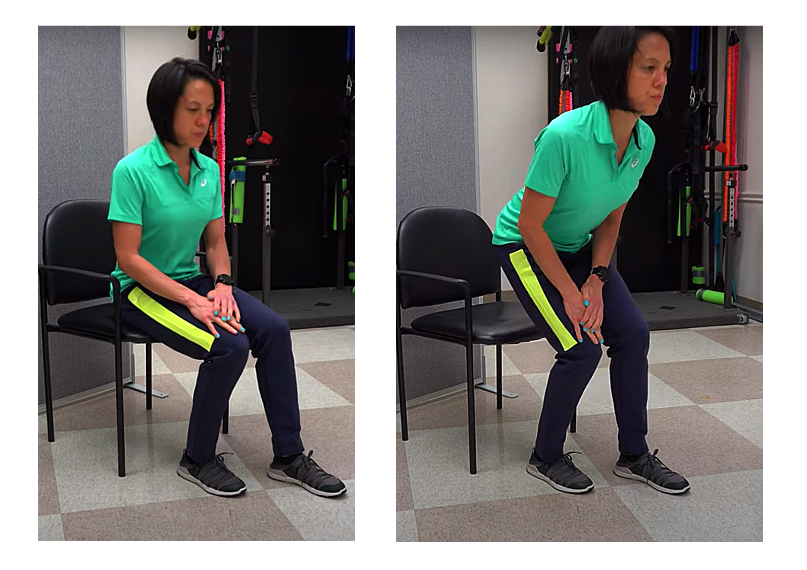Abnormal muscle synergies are one of the most common “movement problems” after a stroke or brain injury.
What is an abnormal muscle synergy?

A flexor synergy is when the hip, knee, and ankle all flex at the same time (visualize drawing your knee into your chest).
An extensor synergy is when all three joints extend (picture a ballerina going up on his/her tippy toe). Um, minus the fact you and I are not trying to do ballet 😫Yeah, HUGE problem.
Are abnormal muscle synergies really a bad thing?
Now, I know I started out by calling this a “movement problem”. However, it does not start out as a “problem”. And therein lies the REAL problem.
You see, an “abnormal muscle synergy” is one of the stages in the stages of motor recovery. Now, here in lies the problem. Many times people get “stuck” in this stage. This is when the “non-problem”…….becomes a problem. Ugh.
Getting “stuck” in this stage of motor recovery
All that being said, this movement problem (that starts out as a non problem), becomes a problem for three main reasons:
Movement is exciting
Generally speaking, “in synergy movement” is typically the first sign of movement after a period of no movement. Therefore, in most cases, people get really excited that their body seems to be recovering. That being said, they just start moving and returning to “normal activities” thinking that this is the beginning of a “complete recovery”. Unfortunately, this is the point when you need to IMMEDIATELY start discouraging these abnormal synergy patterns.
Abnormal synergies are confusing
The second reason this becomes a problem is that “abnormal muscles synergies” can be confusing. For some people, they don’t understand why their body is doing these strange movements. And in this case, they might just stop moving and/or avoid movements.
Abnormal muscle synergies can be painful
And in some cases, these “unnatural” movements can be painful. And in this case, this might also cause someone to stop moving.
How do you successfully progress through the stages of motor recovery?
That being said, ideally, you want to move on to the next stage in the motor recovery process. The next stage is when you learn how to move “out of synergy”.
“Out of synergy” means that you can perform the desired movement at one joint without the other two joints moving. We call this “isolated” joint movement.
For example, someone is struggling with an extensor synergy. In this case, you might notice that when you want to straighten the knee, the foot points. Well, the solution to this would be to “isolate” knee movement. To do this, you would want to work on straightening the knee without letting the foot point. That is just one of many examples of how you would break up a synergy pattern.
You can learn more “isolated” joint movements in this video
More Articles You May Be Interested In:

Regain Normal Walking After a Stroke: Advanced
A common goal after a stroke or a brain injury is to regain "normal walking". However, this goal is not limited to just those who have suffered a stroke. I dare say it is the number one goal of almost everyone who has suffered an injury to their neurologic system. ...

Stand and Walk After a Stroke: Intermediate Progression
Many want to stand and walk after a stroke. Of course, this is critical in giving someone more independence. However, standing and walking is also important to prevent deconditioning, maintain joint health, and prevent postural abnormalities associated with prolonged...

Walking After Stroke (Early Stage)
Walking after a stroke is important to a ton of stroke survivors. A stroke causes hemiplegia (weakness on one side of the body which can make standing and walking difficult. With this in mind, I get a ton of questions from stroke survivors and their...

Spastic ankle guide to stretching
Stretching a spastic ankle is critical to improve standing and walking. However, stretching a spastic ankle can also be extremely challenging. Add to that, NOT stretching a spastic ankle and you are at risk for making it worse. Ugh..... All that being said, never...

Knee Hyperextension after a Stroke: Causes and Treatment
What is Knee Hyperextension after a Stroke? Knee hyperextension is a common problem after a stroke. Knee hyperextension is when the knee goes beyond a straight position. Yeah, not exactly natural looking or feeling. ? Knee hyperextension (recurvatum) usually happens...

Product Spotlight: Stroke Arm Exercise for Spasticity
Spasticity and abnormal movement patterns can make it difficult to perform stroke arm exercise. The Urias air splint can be an invaluable tool to minimize involuntary arm contractions, reduce pain, prevent contractures, and make it one thousand times easier to manage...

Best Method for Stretching Spastic Muscles
Stretching spastic muscles is critical after a stroke. Spasticity is a movement disorder that causes an involuntary muscle contraction in response to lengthening. This occurs if there has been damage to the brain or spinal cord. This can make movement retraining and...
